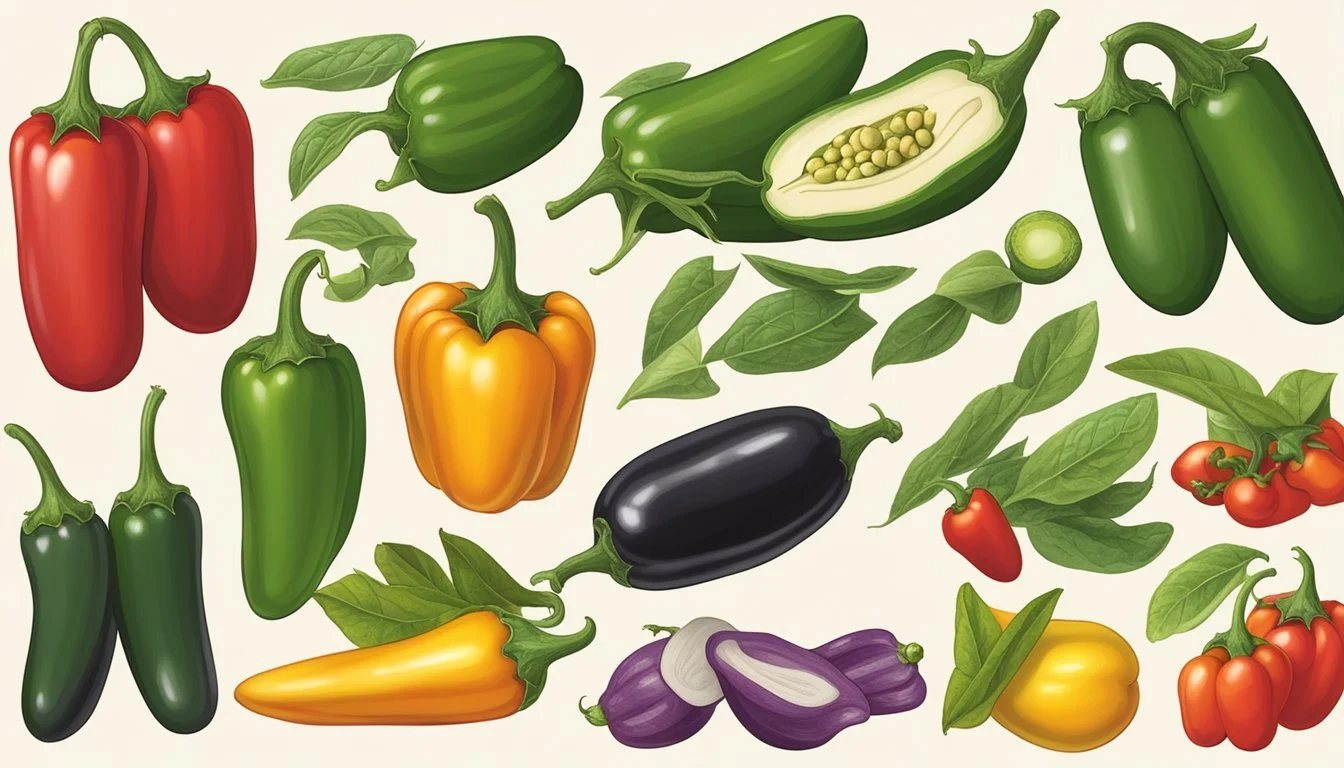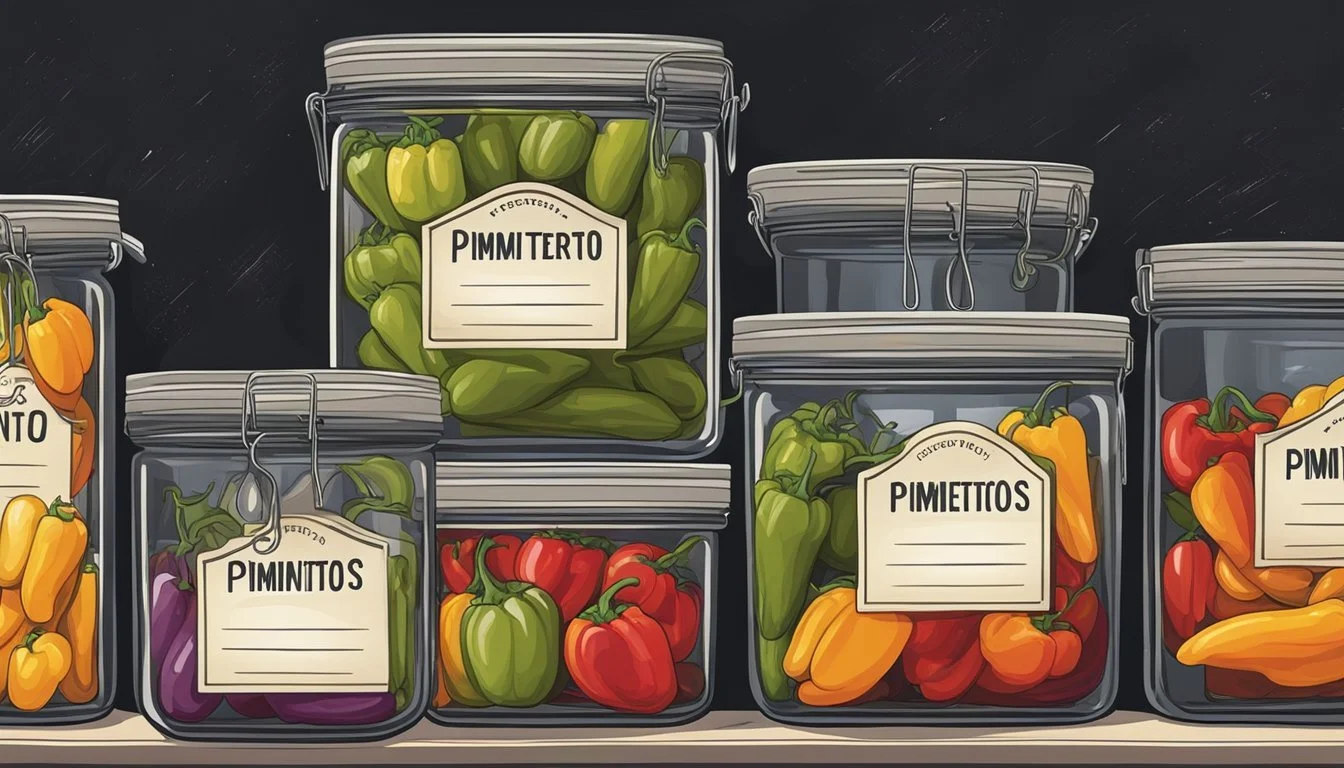Pimientos Substitutes
Top Alternatives for Your Recipes
Finding the perfect substitute for pimientos can be a game-changer in the kitchen. For those seeking a similar flavor and texture, red bell peppers are an excellent alternative since they share many qualities with pimientos and are readily available in most grocery stores. These peppers offer a comparable sweetness and are easy to incorporate into both savory and sweet dishes.
Ground cayenne pepper can step in as another substitute, particularly when a bit of heat is desired in the dish. Using only a fraction of the quantity, it can provide a vibrant flavor with a spicy kick. For those who prefer less spiciness, other options include mixed spice and pumpkin pie spice, which offer a blend of sweetness and mild spice suitable for various recipes.
For dishes needing a smoky, complex flavor, ancho chile powder can be an ideal choice. This spice, derived from dried, mature poblano peppers, injects a rich, smoky taste that enhances soups, salad dressings, and marinades, making it a versatile substitute in many culinary creations.
Understanding Pimientos
Pimientos, also known as cherry peppers, are distinctive for their mild flavor and bright red color. They play a significant role in various cuisines and offer numerous nutritional benefits.
Characteristics of Pimientos
Pimientos are small, heart-shaped sweet peppers from the species Capsicum annuum. They typically have a vibrant red hue and smooth skin.
These peppers are generally mild, lacking the intense heat found in many other capsicums. Instead, they have a sweet and slightly tangy flavor, making them a versatile ingredient in cooking.
Pimientos are cultivated in various regions, particularly those with warm climates, indispensable in Mediterranean and Middle Eastern cuisines.
Culinary Uses
In culinary applications, pimientos provide both color and flavor to dishes. They are often used in salads, stuffing, and as a garnish.
One classic use is in pimento cheese, a popular spread in Southern American cuisine. Additionally, they appear in various Mediterranean dishes, often roasted, sliced, or diced.
Pimientos are commonly found in cans or jars, pickled for extended shelf life. This preservation method enhances their sweetness, making them a consistent staple in recipes.
Nutritional Profile
Pimientos are nutrient-rich, offering several vitamins and minerals. They are particularly high in vitamins A and C, which are essential for immune function and skin health.
These peppers also contain significant amounts of antioxidants, contributing to reduced inflammation and cell protection. They offer iron, which is crucial for blood health, and potassium, important for maintaining healthy blood pressure levels.
A 100-gram serving of pimientos provides about 30 calories, making them a low-calorie addition to diets. Their combination of nutrients supports overall health while adding flavor and color to dishes.
Common Pimento Substitutes
Pimento peppers can be substituted with various peppers that offer similar flavors, ranging from sweet to spicy, as well as non-pepper alternatives that mimic their taste in dishes.
Bell Peppers Varieties
Red Bell Peppers are a popular substitute. They share a similar sweetness and mild flavor, making them ideal for salads, salsas, and cooked dishes. Roasted red bell peppers, available canned or jarred, can provide a smoky depth akin to roasted pimentos and are convenient for recipes like pimento cheese.
Cubanelle Peppers offer a mild, sweet flavor. While less sweet than pimentos, they still fit well in most recipes. They’re especially useful for stuffing or sautéing.
Piquillo Peppers are another suitable option. These small, sweet red peppers from Spain can be found roasted and canned, offering a tender texture that works well in a variety of dishes, including sauces and stews.
Peppers with a Sweet Profile
Peppadew Peppers are known for their unique tangy sweetness. These small, round red peppers are pickled, adding a slight tang that complements the sweetness. Suitable for salads, sandwiches, and as a topping for pizzas, they bring a distinct flavor twist to dishes.
Cherry Peppers, both sweet and mildly spicy, can be used in place of pimentos. Their round shape and vibrant red color make them a visually appealing substitute in recipes requiring diced or chopped pimentos.
Spicy Alternatives
Ground Cayenne Pepper can be used for those who prefer a kick. While much spicier than pimentos, a small amount can emulate the heat in savory recipes. It’s recommended to use 1/3 to 1/2 teaspoon of cayenne for every teaspoon of pimento.
Paprika, particularly sweet paprika, provides a milder heat with a similar flavor profile. It’s versatile in various dishes, from stews to seasoning blends, offering a touch of color and mild spiciness without overwhelming the dish.
Non-Pepper Substitutes
Mixed Spice Blends, such as pumpkin pie spice, can replace pimento in sweet dishes. These blends offer a mix of sweetness and mild spiciness that pairs well with desserts and baked goods.
Ground Nutmeg or Mace provides a warm, slightly sweet flavor. It can be used in small amounts to simulate the taste of pimento in both sweet and savory dishes, making it a versatile pantry substitute.
Star Anise has a potent, aromatic flavor similar to pimento in sauces and stews. It’s particularly effective in recipes where an intense spice is welcome, though it should be used sparingly due to its strong flavor.
Choosing the Right Substitute
When selecting a substitute for pimientos, it is important to consider the specific needs of the recipe, such as heat levels, texture, and availability of alternatives. These aspects will guide you in making the most suitable choice for your dish.
Considering the Recipe
The first aspect to consider is the recipe itself. Different dishes may require different substitutes based on the intended flavor and texture. For example, if the recipe calls for pimientos in a salad, using sweet bell peppers can be a good option due to their similar sweetness and mild flavor. Conversely, if the recipe requires a spice blend, ground paprika might be more appropriate.
Heat Levels in Peppers
Pimientos are known for their sweet and mild flavor, registering very low on the Scoville scale. When choosing a substitute, it's important to match the heat level. Sweet bell peppers, for instance, have no heat and are often used as a direct substitute. On the other hand, if a slightly more spicy option is acceptable, mild red chili peppers can be considered, but it's crucial to avoid overly spicy options that might overpower the dish.
Textural Impact on Dishes
The texture of the substitute plays a significant role, especially in dishes where pimientos are used in their whole or chopped form. Fresh pimientos are crisp and have a slightly juicy consistency. Red bell peppers and piquillo peppers offer a similar texture. If the recipe requires a softer texture, like in a pepper spread, roasted red peppers can be an ideal substitute due to their tender and flavorful nature.
Substitutes Based on Availability
Availability and price are also critical factors. Pimientos might not always be available at local grocery stores. In such cases, common and affordable alternatives include red bell peppers and paprika. Bell peppers are widely available and budget-friendly. Additionally, pickled pimientos can be a good substitute when fresh options are scarce. These substitutes can be easily sourced and are often economical, making them practical choices for various recipes.
Incorporating Substitutes in Various Dishes
Using pimiento substitutes can enhance the flavors of your recipes, whether they are salads, stews, or sauces. Understanding how to adjust flavors and the correct substitution ratios is crucial for achieving the desired taste.
Adjusting Flavors in Recipes
When substituting pimientos, it's important to consider the unique flavor profiles of the substitutes. Red bell peppers are versatile and readily available, ideal for dishes like stuffings and casseroles. They offer a mild sweetness and crisp texture, suitable for salads and everyday cooking.
For a smoky and spicy kick in curries or stews, ancho chile powder is a good choice. It can transform soups and marinades by delivering depth and warmth. On the other hand, ground cayenne pepper can replace ground pimento in sauces and dressings, providing heat without bitterness.
In sweet recipes or desserts, ground nutmeg or mace can mimic the subtle warmth and aromatic notes of pimiento, enhancing the overall flavor without overpowering other ingredients.
Substitute Ratios
Correct substitution ratios ensure that flavors remain balanced. Red bell peppers can substitute pimientos in a 1:1 ratio in salads and pickling, offering similar sweetness but a crisper bite.
For powdered substitutes, different ratios apply. Use 1/2 to 1/3 teaspoon of ground cayenne pepper per teaspoon of ground pimento when making sauces or dressings. This prevents overpowering spiciness.
Ancho chile powder is more potent; hence, a smaller amount, around 1/4 teaspoon per teaspoon of pimiento, is recommended for stews and curries. When using ground nutmeg or mace in desserts, start with 1/2 teaspoon to maintain a subtle, complementary flavor. Adjust accordingly based on taste and the specific dish requirements.
Pimientos in Global Cuisine
Pimientos, or pimentos, are native to regions like Spain and play a significant role in diverse global cuisines. Different cultures have incorporated both sweet and spicy varieties of these peppers into their traditional recipes.
Spanish Dishes
In Spanish cuisine, pimientos are a staple ingredient, often seen in tapas and paellas. They are also popular in Spanish green olive stuffing, adding a subtle sweetness and vibrant color. Pimientos de Padrón, a small green variety of pimentos, are frequently fried and served as appetizers, occasionally surprising diners with their unpredictable spicy punch.
Italian Influence
Italian cuisine embraces pimientos, primarily sweet peppers, in a variety of dishes. They are especially prevalent in antipasti platters, where they are marinated and paired with Italian sweet peppers. Additionally, they are a key ingredient in peperonata, a sweet pepper stew that highlights the natural flavors of the peppers. These peppers also find their way into stuffed pepper recipes, enhancing both taste and presentation.
Adoption in South African Cuisine
South African dishes also benefit from the inclusion of pimientos, which are often used to add flavor and color to spicy relishes and chutneys. The influence of various immigrant communities is evident in South African cooking, where pimiento substitutes might include local peppers adapted to fit native recipes. This integration illustrates the versatility of pimientos in enriching regional dishes with their unique taste.
Additional Varieties and Their Uses
Exploring a range of peppers helps diversify culinary options. Sweet peppers and spicy variants offer unique flavors and textures, providing suitable alternatives in various recipes.
Lesser-Known Sweet Peppers
Holland Sweet Peppers are characterized by their vibrant colors and sweet taste. They can be used in salads, sautés, and as toppings for pizzas. They maintain their crunchiness even when cooked, adding texture to dishes.
Corno di Toro peppers, also known as "bull's horn" peppers, are elongated and have a sweet, mild flavor. They work well in roasting, grilling, or stuffing due to their thick flesh.
Cherry Peppers are small and round, often used in pickling. Their sweetness makes them a delightful addition to antipasto platters, salads, and tapas.
Piquillo Pepper is another sweet variety, typically found in Spanish cuisine. They are perfect for roasting and stuffing due to their thick walls and mild flavor, often used in tapas and traditional Spanish dishes.
Uncommon Spicy Variants
Banana Peppers are mild to moderately hot and can be used fresh or pickled. They add a tangy flavor to sandwiches, salads, and pizzas. When pickled, they can be a zesty accompaniment to foods like hot dogs and burgers.
Capsicum Annuum includes varieties such as cayenne and jalapeño. These peppers bring significant heat and can be used in sauces, marinades, and seasonings. Cayenne pepper, ground into powder, offers a spicy kick in various recipes.
Ancho Chile Powder provides a smoky and spicy flavor. It is derived from dried poblano peppers, commonly used in Mexican dishes, adding depth to soups, stews, and marinades.
Piquillo Pepper when dried and powdered, infuses dishes with a milder heat compared to more intense chili peppers. It’s commonly used in Spanish and Mediterranean cuisine to add a subtle warmth.
Alternative Spices and Seasonings
When pimientos are unavailable, various spices and seasonings can effectively replicate their unique flavor profile. These substitutes can either be blends of multiple spices or single spices that closely match the taste and aroma of pimientos.
Comparable Spice Blends
Blends like five-spice powder and mixed spice can be excellent pimiento substitutes. Five-spice powder, a combination of cinnamon, fennel seed, cloves, star anise, and white pepper, brings a complex flavor that enhances many dishes.
Mixed spice typically contains cinnamon, nutmeg, and cloves, offering a sweet and spicy flavor reminiscent of pimientos. These blends are versatile and can be used in both sweet and savory dishes, making them a valuable addition to your spice collection.
Single Spices as Alternates
For simpler substitutions, single spices can effectively mimic pimientos' taste.
Paprika is a common and easily accessible alternative, providing a similar mild heat and sweetness. Ground allspice and cinnamon can also mimic the sweet notes of pimientos, while nutmeg or mace add a warm, spicy flavor.
Ground cloves and red pepper flakes bring a bit more heat, suitable for recipes requiring a spicier kick. Using these spices individually allows for precise control over the flavor profile of your dish.
Storage and Preservation
Proper storage and preservation techniques ensure that pimientos and their substitutes maintain their flavor and usability. The methods discussed include extending shelf life and homemade preservation strategies, including canning and freezing.
Extending Shelf Life
Pimientos and similar peppers should be stored properly to maximize their shelf life. Fresh pimientos can be kept in the refrigerator in a crisper drawer. To store them, place the peppers in a paper towel-lined plastic bag, which helps absorb excess moisture.
Canned pimientos, once opened, should be transferred to a glass jar with a tight seal if the original can isn't resealable. Store these jars in the fridge, ensuring they remain submerged in their brine to prevent spoilage.
Bell peppers and other fresh substitutes, like cubanelle peppers, should also be refrigerated and used within 1-2 weeks. Pickling is another effective way to extend the shelf life of peppers, providing a shelf-stable option when stored in a cool, dark place.
Homemade Preservation Techniques
Homemade preservation methods for pimientos include freezing, pickling, and canning. To freeze pimientos, start by roasting them at 400-450°F for 6-8 minutes or until their skins blister. Peel off the skins, remove the stems and seeds, then package them in airtight containers or freezer bags, leaving a 1/2-inch headspace.
Pickling involves soaking the peppers in a mixture of vinegar, water, salt, and sugar. This method allows for long-term storage and can alter the flavor profile depending on the spices used.
Canning is another effective method; it requires roasting and peeling the peppers before placing them in sterilized jars with brine. Ensuring proper headspace and sealing the jars helps prevent spoilage. Pressure canning may be necessary for low-acid varieties.
These preservation methods not only extend the usability of pimientos but also retain their unique flavors and textures.










